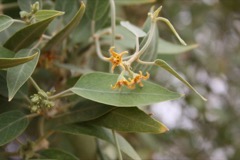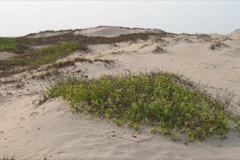 |
|
Marco Schmidt; African plants |
 |
| Rainer Wendt; African plants |
Translate this page:
Summary
Synonym of Leptadenia lanceolata subsp. lanceolata. Found in tropical Africa particularly in Senegal to Ethiopia, Uganda, and Kenya, Leptadenia hastata is a climbing shrub producing many soft stems that become woody at the base. It thrives well under harsh and dry, and poor soil conditions. Established plants are tolerant to drought. The leaves are alternate and taper towards the tip. The stems are light green and young shoots curve upwards. The flowers are greenish-yellow. The fruits are cone-shaped which release cottony winged seeds as they split open. Young leaves, young shoots, and flowers are cooked and added to soups. Young shoot tips are sometimes eaten raw. The plant further has medicinal uses. It contains a milky sap that has a wide variety of uses for treating different conditions. The fruits are dried and used as a tinder.
Physical Characteristics

 Leptadenia hastata is an evergreen Perennial Climber growing to 1.5 m (5ft) by 0.2 m (0ft 8in) at a medium rate.
Leptadenia hastata is an evergreen Perennial Climber growing to 1.5 m (5ft) by 0.2 m (0ft 8in) at a medium rate.
See above for USDA hardiness. It is hardy to UK zone 10. The plant is self-fertile.
It is noted for attracting wildlife.
Suitable for: light (sandy), medium (loamy) and heavy (clay) soils, prefers well-drained soil and can grow in nutritionally poor soil. Suitable pH: mildly acid and neutral soils. It cannot grow in the shade. It prefers dry or moist soil and can tolerate drought.
UK Hardiness Map
US Hardiness Map
Synonyms
Cynanchum hastatum Pers. Cynanchum lanceolatum Poir. Cynanchum lancifolium Schumach. Cynanchum scabr
Plant Habitats
Edible Uses
Edible Parts: Flowers Leaves Shoots
Edible Uses:
Young leaves and young shoots - cooked and added to soups. The young shoot-tips are sometimes eaten raw[332 ]. The chopped and boiled leaves are mixed with beans, pigeon peas or cowpeas[299 ]. The leaves of plants grown at Dakar have been analysed as containing: carbohydrates 46%, protein 18%, ash 14%, oil 6% by weight. Calcium was present at 2.06%, potassium 1.74%, with magnesium, sodium, phosphorous and numerous minor elements, the principal one being iron, and amino-acids[332 ]. Flowers - cooked and added to soups[332 ]. In a survey on the preference for 14 wild herbaceous vegetables that was held in Burkina Faso in 1999, this species ranked 3rd; its taste was considered good, and its tolerance of drought, insects and poor soil conditions as very good[299 ].
References More on Edible Uses
Medicinal Uses
Plants For A Future can not take any responsibility for any adverse effects from the use of plants. Always seek advice from a professional before using a plant medicinally.
Antidiarrhoeal Antihaemorrhoidal Antiinflammatory Diuretic Laxative Leprosy Ophthalmic Stomachic
The plant contains a milky sap and this has lead, by allusion, to it being used in the treatment of a wide range of ailments symptomized by discharges, or a lack of them[332 ]. The plant is very strongly diuretic and generally strongly stimulates the flow of urine[332 ]. In it also often used with a range of other plants to treat various conditions, including treating suckling babies who have green diarrhoea; for all vein troubles such as varicose veins, bleeding and painful haemorrhoids; poisonings; anuria; syphilis; leprosy; trypanosomiasis, etc. In short, it is used as a general panacea[332 ]. Combined with the root of Smilax spp., it is used to treat for tertiary syphilis[332 ]. The latex contains the triterpene lupeol and derivatives of it, which possess anti-inflammatory activity[299 ]. The sap, or the whole leaf-petiole rolled up into a spill, is put in the nose as a treatment for head-colds and head pains. The latex is put on wounds[332 ]. The sap, or the root in decoction, is used for treating ophthalmia[332 ]. A root macerate is taken to treat anuria or constipation[332 ].The powdered roots in water are taken as a stomachic[332 ]. A macerate or decoction of the whole plant is used to treat urethral discharge, abdominal complaints[332 ]. A macerate or decoction of the leaves is used to remedy a lack of breast-milk, impotence, gonorrhoea and stomach-ache in children[332 ].
References More on Medicinal Uses
The Bookshop: Edible Plant Books
Our Latest books on Perennial Plants For Food Forests and Permaculture Gardens in paperback or digital formats.

Edible Tropical Plants
Food Forest Plants for Hotter Conditions: 250+ Plants For Tropical Food Forests & Permaculture Gardens.
More

Edible Temperate Plants
Plants for Your Food Forest: 500 Plants for Temperate Food Forests & Permaculture Gardens.
More

More Books
PFAF have eight books available in paperback and digital formats. Browse the shop for more information.
Shop Now
Other Uses
Fibre Tinder
Agroforestry uses: Leptadenia hastata can be used as a forage plant for livestock, and its deep roots help in soil stabilization and erosion control.
A fibre, without recorded use, can be obtained from the stem[332 ]. The dried fruits are used as a tinder[332 ]. 1. Nectary - Flowers rich in nectar and pollen:
Yes – Leptadenia hastata produces flowers that attract pollinators like bees due to their nectar and pollen.
2. Wildlife - Food (Fruit, Seeds, Leaf litter, Shelter, Nesting, Roosting):
Yes – The plant provides food in the form of its edible leaves and possibly fruit for wildlife. It also offers some shelter and cover, though it’s more of a climbing plant and less dense than trees.
3. Invertebrate Shelter (Overwintering sites, Leaf litter, Groundcover):
Yes – The plant’s structure and leaves can provide overwintering sites and shelter for invertebrates, and its growth can contribute to groundcover.
4. Pest Confuser (Smell):
No – Leptadenia hastata is not known for emitting a smell that confuses pests.
Special Uses
References More on Other Uses
Cultivation details
A plant of semi-arid areas in the tropics. Succeeds in poor soil conditions[299 ]. Established plants are drought-tolerant [299 ]. Leptadenia hastata is generally considered to be self-fertile. The leaves and young shoots can be harvested throughout the growing season, the best time being spring to early summer.
It usually flowers from late spring to early summer, depending on the local climate.
References Carbon Farming Information and Carbon Sequestration Information
Temperature Converter
Type a value in the Celsius field to convert the value to Fahrenheit:
Fahrenheit:
The PFAF Bookshop
Plants For A Future have a number of books available in paperback and digital form. Book titles include Edible Plants, Edible Perennials, Edible Trees,Edible Shrubs, Woodland Gardening, and Temperate Food Forest Plants. Our new book is Food Forest Plants For Hotter Conditions (Tropical and Sub-Tropical).
Shop Now
Plant Propagation
Seed -
Other Names
If available other names are mentioned here
Akamongot, Anvara, Akamongot, Anvara, Be-thacare, Bissacra, Cheila, Chesakisyon, Cibode, Kayilla, Lelogo, M'bafecabuduco, Meta, Metsa, Moroh, Ndedeweck, N'rocde, Njera, Safaro, Safarodje, Sapate, Xeyla, Ya'diya, akamongot, anvara, chesakisyon, ekamong'o, lélogo, moroh.
Native Range
Algeria, Benin, Burkina, Cameroon, Central African Republic, Chad, Ethiopia, Gambia, Ghana, Guinea, Guinea-Bissau, Ivory Coast, Kenya, Libya, Mali, Mauritania, Niger, Nigeria, Senegal, Sudan, Tanzania, Uganda.
Weed Potential
Right plant wrong place. We are currently updating this section.
Please note that a plant may be invasive in one area but may not in your area so it's worth checking.
Conservation Status
IUCN Red List of Threatened Plants Status : This taxon has not yet been assessed

Growth: S = slow M = medium F = fast. Soil: L = light (sandy) M = medium H = heavy (clay). pH: A = acid N = neutral B = basic (alkaline). Shade: F = full shade S = semi-shade N = no shade. Moisture: D = dry M = Moist We = wet Wa = water.
Now available:
Food Forest Plants for Mediterranean Conditions
350+ Perennial Plants For Mediterranean and Drier Food Forests and Permaculture Gardens.
[Paperback and eBook]
This is the third in Plants For A Future's series of plant guides for food forests tailored to
specific climate zones. Following volumes on temperate and tropical ecosystems, this book focuses
on species suited to Mediterranean conditions—regions with hot, dry summers and cool, wet winters,
often facing the added challenge of climate change.
Read More
Expert comment
Author
(Pers.) Decne.
Botanical References
Links / References
For a list of references used on this page please go here
A special thanks to Ken Fern for some of the information used on this page.
Readers comment
| Add a comment |
|
If you have important information about this plant that may help other users please add a comment or link below. Only comments or links that are felt to be directly relevant to a plant will be included. If you think a comment/link or information contained on this page is inaccurate or misleading we would welcome your feedback at [email protected]. If you have questions about a plant please use the Forum on this website as we do not have the resources to answer questions ourselves.
* Please note: the comments by website users are not necessarily those held by PFAF and may give misleading or inaccurate information.
To leave a comment please Register or login here All comments need to be approved so will not appear immediately.
|
Subject : Leptadenia hastata
|
|
|
|